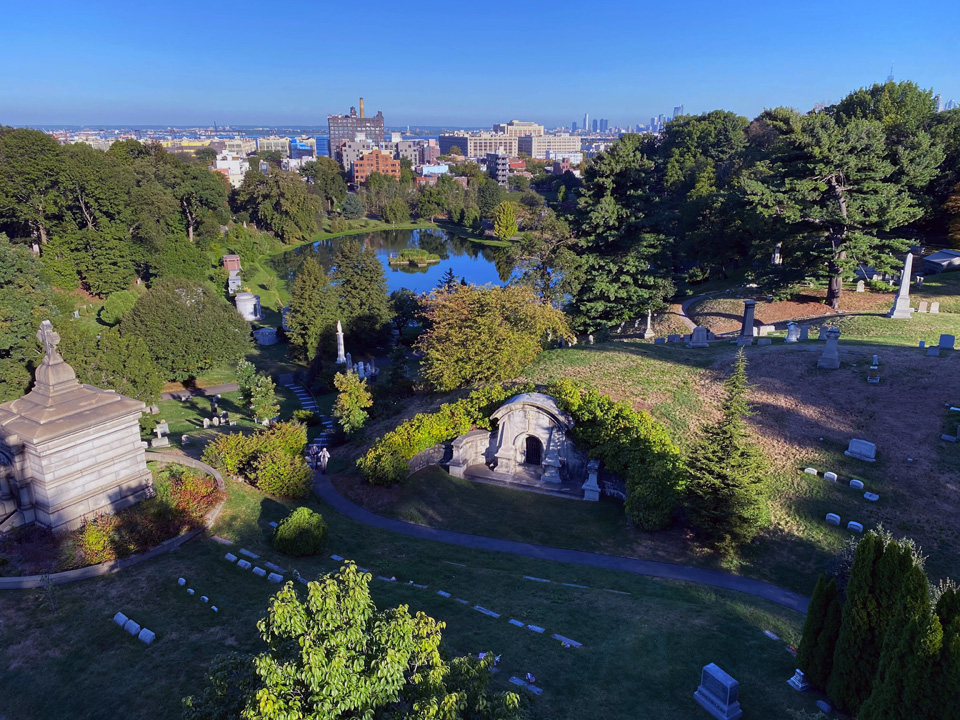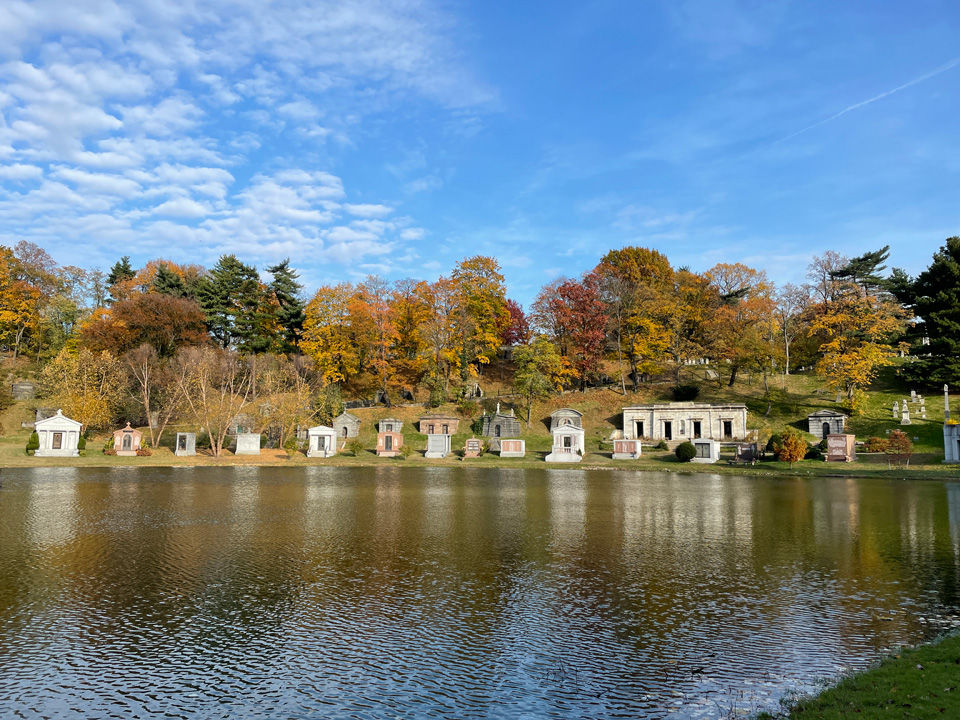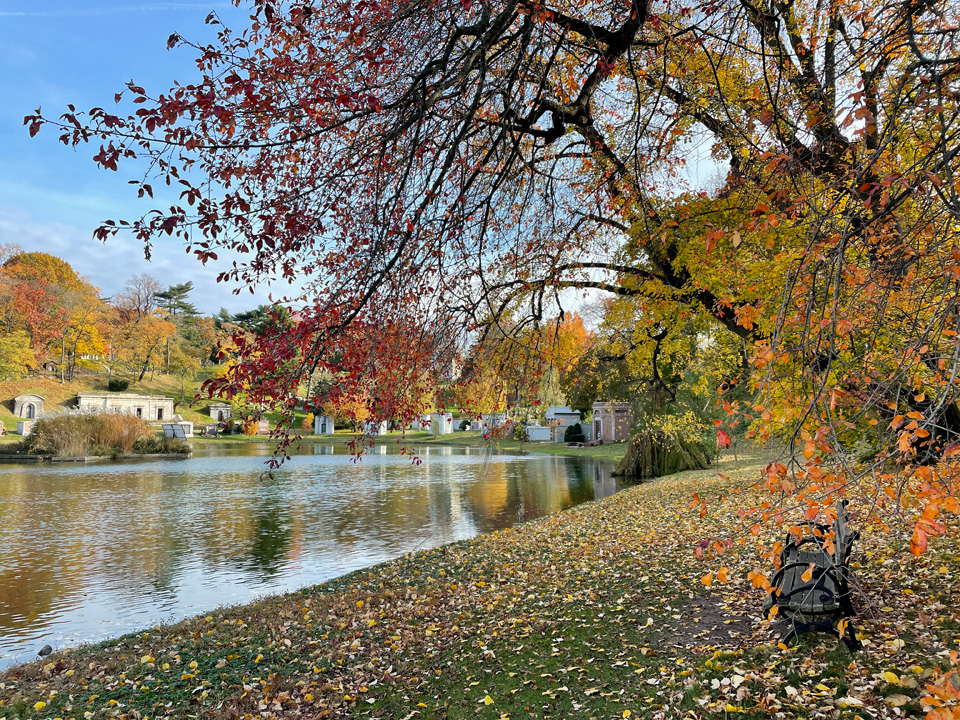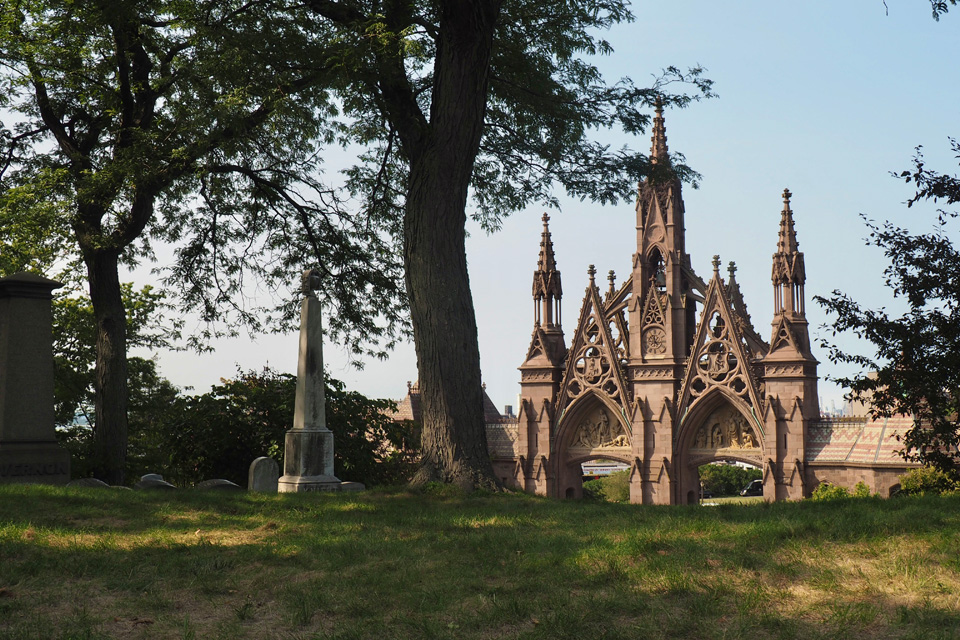The Green-Wood Cemetery Gets Climate Ready with Stormwater Resiliency Project
October 13, 2022
Green Infrastructure Improvements at 478-acre National Historic Landmark Supported by DEP’s New Resilient NYC Partners Program will Create Additional Capacity in Brooklyn’s Sewer System
The New York City Department of Environmental Protection (DEP) and New York State Environmental Facilities Corporation (EFC) are pleased to announce a major stormwater resiliency initiative—one of the largest in scale to be undertaken at a private property in New York City—at The Green-Wood Cemetery, a National Historic Landmark. Made possible by DEP’s Resilient NYC Partner's Program and EFC’s Green Innovation Grant Program, this project is an inventive example of how public and private entities can work in partnership to increase New York City’s stormwater resilience in a changing climate.
At 478 acres, Green-Wood is one of the largest contiguous tracts of privately-owned land in New York City, offering immense opportunity to alleviate the amount of runoff that flows into the city’s combined sewage system and thereby creating additional capacity to help manage the more intense storms brought on by climate change. A variety of green stormwater practices, such as a pond retrofit with smart sensors, the installation of bioretention basins along impervious surfaces, subsurface storage, and a new rainwater harvesting system will manage an estimated 51 million gallons of stormwater runoff annually. The improvements are slated for completion by 2024 and will reduce localized flooding as well as the discharge of pollution into New York Harbor during intense storms. The rainwater harvesting system will enable Green-Wood Cemetery to reduce the amount of potable water the cemetery uses to irrigate its scenic landscape.

The project is the first to benefit from DEP’s $53 million Resilient NYC Partners program that engages private property owners across the five boroughs to green their properties and manage stormwater onsite. The Green-Wood Cemetery will be provided with a $600,000 grant from DEP for the stormwater project.
“We have already built more than 11,000 green infrastructure installations, mostly on public property, across the city to soak up stormwater, but in order to make New York City resilient to the severity of storms that climate change is creating, we require better management of the stormwater that falls on private property,” New York City Department of Environmental Protection Commissioner Rohit T. Aggarwala said. “This is why we’re so pleased to join forces with New York State, The Nature Conservancy and The Green-Wood Cemetery on this innovative green infrastructure project on private property that will manage enough water to fill more than 77 Olympic-sized swimming pools!”
“Today’s announcement exemplifies New York State’s continued investment in resilient water quality infrastructure that safeguards against the impacts of climate change,” New York State Environmental Facilities Corporation (EFC) President & CEO Maureen A. Coleman said. “EFC is pleased to provide a $1.775 million grant in support of this stormwater project at the national landmark The Green-Wood Cemetery, that will result in water quality improvements in the surrounding Brooklyn neighborhood. Under the leadership of Governor Hochul, EFC’s Green Innovation Grant Program supports projects across the state that utilize green stormwater infrastructure design and create cutting-edge green technologies. EFC has awarded $223 million through the Green Innovation Grant Program since its inception, and EFC looks forward to announcing the next round of awards later this year.”

“The dramatic effects of climate change have reached all corners of the globe, and Brooklyn is no exception,” Richard Moylan, President at The Green-Wood Cemetery said. “Weather events like Superstorm Sandy, Hurricane Isaias, and other major rainfalls are happening on a regular basis, and urban institutions will all have to do their part to mitigate their consequences. This initiative affirms Green-Wood’s commitment to the urban environment and combating climate change, and its impact on our city’s waterways and the water quality of its surrounding neighborhoods will be substantial. As one of the largest bioretention projects in New York City, this project will also serve as an example for public and private urban institutions across our country.”
“More than 90 percent of all urban and suburban lands in the U.S. are privately held, making partnerships with private landowners—like Green-Wood—critical to meeting community water management goals,” said Craig Holland, Senior Director of Investments at The Nature Conservancy. “The Nature Conservancy and Brightstorm are pleased to help facilitate public-private partnerships that are necessary to achieve success at scale.”
Green-Wood first partnered with URBANSEA, an urban resilience analytics startup, to apply for and secure state funding. The Nature Conservancy then joined to provide technical consulting and coordination of funding streams. Brightstorm, an initiative of The Nature Conservancy, will manage the implementation of the project on behalf of Green-Wood Cemetery. A public procurement process will commence next month to engage multidisciplinary firms for the design of the project.

The New York City Department of Environmental Protection
DEP manages New York City’s water supply, providing approximately 1 billion gallons of high-quality drinking water each day to nearly 10 million residents, including 8.8 million in New York City. The water is delivered from a watershed that extends more than 125 miles from the city, comprising 19 reservoirs and three controlled lakes. Approximately 7,000 miles of water mains, tunnels and aqueducts bring water to homes and businesses throughout the five boroughs, and 7,500 miles of sewer lines and 96 pump stations take wastewater to 14 in-city treatment plants. DEP also protects the health and safety of New Yorkers by enforcing the Air and Noise Codes and asbestos rules. For more information, visit nyc.gov/dep, like us on Facebook, or follow us on Twitter.
The New York State Environmental Facilities Corporation
The Environmental Facilities Corporation helps local governments and eligible organizations undertake their water infrastructure projects. EFC provides state and federal grants as well as interest-free and low-cost financing to help ensure projects are affordable while safeguarding essential water resources. EFC administers New York's Clean Water and Drinking Water State Revolving Funds and federal and state grants in partnership with DEC and DOH. EFC uses multiple financing strategies to maximize the funding that can be made available to communities.
The Green-Wood Cemetery
Established in 1838, The Green-Wood Cemetery, a National Historic Landmark, is recognized as one of the world’s most beautiful cemeteries. As the permanent residence of over 570,000 individuals, Green-Wood’s magnificent grounds, grand architecture, and world-class statuary have made it a destination for half a million visitors annually, including national and international tourists, New Yorkers, and Brooklynites. At the same time, Green-Wood is also an outdoor museum, an arboretum, and a repository of history. Throughout the year, it offers innovative programs in arts and culture, nature and the environment, education, workforce development, restoration, and research. For more information, please visit www.green-wood.com.
The Nature Conservancy
The Nature Conservancy is a global conservation organization dedicated to conserving the lands and waters on which all life depends. Guided by science, we create innovative, on-the-ground solutions to our world’s toughest challenges so that nature and people can thrive together. We are tackling climate change, conserving lands, waters and oceans at an unprecedented scale, providing food and water sustainably and helping make cities more sustainable. Working in 76 countries and territories—37 by direct conservation impact and 39 through partners—we use a collaborative approach that engages local communities, governments, the private sector, and other partners. To learn more, visit www.nature.org or follow @nature_press on Twitter.





